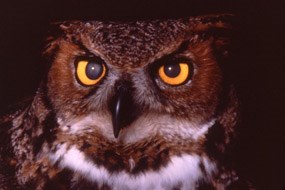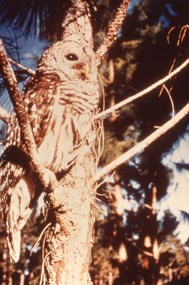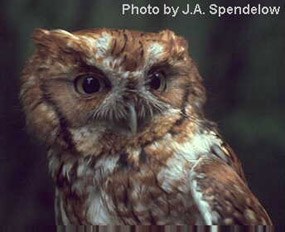
NPS COLLECTION Silent Fliers of the Upland Forests Both the great horned owl and the barred owl can be heard in the evening, and at times seen within their nesting territories. The best time to listen for owls is early morning before dawn when they are most active. Listen for the hooting call of the great horned owl, “hoo, hoo-oo, hoo, hoo” and the "who cooks for you, who cooks for you all" of the barred owl. The screech owl has a descending wailing trill, sometimes sung as a single note. 
NPS COLLECTION Great horned owls use existing nests of other birds and have been known to nest along the trails surrounding Happy Days Lodge. They are often referred to as “tigers of the sky” for their ability to tackle any prey their size, including other owls, and approaching with complete silence and pinpoint accuracy. Barred owls often nest within patches of evergreen trees. Look and listen for them along the Tree Farm and Oak Hill trails. 
PHOTO BY by J.A. SPENDELOW Screech owl coloring is referred to as either grey or red phase due to rusty or dark gray patterned plumage. On bright sunny days, look for them capturing the warm sunlit rays from their nesting cavities, typically in large sycamore trees. You will need to look closely, for the small owls are usually well camouflaged.

NPS COLLECTION Also This Month Unusual small flocks of purple finches are frequently seen along the edges of old fields and forests surrounding Oak Hill. Along the Ledges trails look for feeding pileated woodpeckers on decaying large oak trees. Photo Gallery January Birds3 Images Look for several active species of birds when walking throughout Cuyahoga Valley National Park in January. |
Last updated: April 10, 2015

